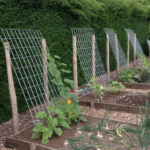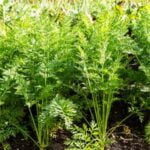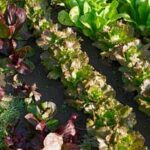Container vegetable gardens offer a convenient and flexible solution for gardening enthusiasts of all levels. Whether you have limited space, want the ability to move your garden around, or simply enjoy the convenience of having fresh produce right at your fingertips, container vegetable gardens are an excellent option to consider.
In this article, we will explore the benefits of container vegetable gardens, discuss how to select the perfect containers for your garden, provide essential tools and materials needed to get started, and offer tips on choosing the right vegetables for your unique setup.
Additionally, we will delve into planning and designing techniques to maximize space and aesthetics, share care tips for watering, fertilizing, and pest control, showcase innovative ways to use vertical space in container gardens, and even present inspiring examples of real-life success stories and stunning designs. If you’ve been contemplating starting your own vegetable garden but don’t have a traditional outdoor space or large plot of land, container gardening may be just the solution you’re looking for.
So let’s dive in and discover the world of container vegetable gardens together.
The Benefits of Container Vegetable Gardens
Container vegetable gardens offer numerous benefits, making them a great solution for gardening enthusiasts, regardless of the limitations they may have. Whether you live in a small apartment with no outdoor space or you simply want the flexibility to move your garden around, container vegetable gardens can provide the perfect solution.
Limited Space
One of the primary benefits of container vegetable gardens is that they allow you to grow your own vegetables even if you have limited space. With containers, you can utilize balconies, patios, rooftops, and windowsills to create a thriving garden. This is especially advantageous for urban dwellers who often lack access to traditional garden beds. Container gardening allows you to maximize every available inch of your living area and transform it into productive growing space.
Portability
Another advantage of container vegetable gardens is their mobility. Unlike traditional gardens that are fixed in one location, containers give you the freedom to move your plants around as needed. If you notice that your plants are getting too much or too little sunlight in a particular spot, simply relocate them to a more suitable location.
This flexibility is particularly beneficial for those who rent their homes or frequently change residences. Additionally, portable containers enable gardeners to extend the growing season by moving plants indoors during inclement weather or freezing temperatures.
No Soil Constraints
Container gardening also eliminates concerns related to poor soil quality or contamination. By using high-quality potting mix specifically designed for vegetables, you can ensure optimal conditions for healthy plant growth without worrying about soil-borne diseases or contaminated earth. Moreover, container vegetable gardens allow individuals with physical limitations who may find it difficult to work directly in the ground to still enjoy the pleasures of gardening.
Overall, container vegetable gardens provide an excellent alternative for those with limited space or a need for mobility. By utilizing various types of containers and taking advantage of their portability and versatility, anyone can cultivate a productive and beautiful garden, no matter the constraints they may face.
Selecting the Perfect Containers for Your Vegetable Garden
When starting a container vegetable garden, selecting the right containers is crucial for the success of your plants. Not only do you want something functional and durable, but you also want containers that add a touch of creativity and aesthetics to your outdoor or indoor space. Here are some creative and functional options to consider:
Terra Cotta Pots
Terra cotta pots are classic and timeless choices for container gardens. They come in various sizes, shapes, and designs, allowing you to find the perfect fit for your vegetable plants. The porous nature of terra cotta allows for excellent drainage, preventing overwatering and root rot. These pots also provide thermal insulation, keeping the roots cool in hot weather.
Fabric Grow Bags
Fabric grow bags have gained popularity among container gardeners due to their lightweight nature and excellent drainage capabilities. Made from breathable fabric material, they allow air to circulate through the soil, promoting healthy root growth. Fabric grow bags are also collapsible and easy to store when not in use.
Trellises with Planters
If you’re looking to maximize vertical space in your container garden, trellises with attached planters are an excellent option. They come in various sizes and materials such as metal or wood. This design allows vining vegetables like tomatoes or cucumbers to climb up while still providing ample room for other smaller plants at the base.
Hanging Baskets
Hanging baskets are a fantastic choice for those with limited floor space or who want to add a decorative element to their gardens. They can be hung from walls, railings, or hooks suspended from above. Choose baskets with sturdy construction that can support the weight of both soil and plants.
When selecting containers for your vegetable garden, make sure they have drainage holes at the bottom to prevent waterlogged roots. Additionally, consider the size of the container and the plant’s root depth requirements. Some vegetables, like carrots or potatoes, may need deeper containers to accommodate their roots.
Remember that the choice of containers should not only be functional but also suit your personal style and complement your overall garden design. With the wide variety of options available, you can get creative and experiment with different styles to make your container vegetable garden uniquely yours.
Essential Tools and Materials for Container Vegetable Gardens
Container vegetable gardens are a convenient and versatile way to grow your own fresh produce, even if you have limited space. To get started with your container garden, there are some essential tools and materials that you will need.
Firstly, you will need containers suitable for growing vegetables. Options include traditional clay or plastic pots, hanging baskets, window boxes, or even repurposed items such as buckets or old water troughs. It is important to choose containers that are the appropriate size for the vegetables you plan to grow. Larger plants like tomatoes or peppers will require larger containers while smaller plants like lettuce or herbs can thrive in smaller pots.
In addition to containers, you will also need potting soil specifically formulated for vegetable gardening. Avoid using regular garden soil as it can become compacted in containers and can often contain pests or diseases. Look for a well-draining potting mix that is rich in organic matter.
To keep your container vegetable garden thriving, invest in some quality hand tools such as a trowel, hand pruners, and a small shovel. These tools will come in handy for planting, pruning, and maintaining your plants as they grow. Additionally, a watering can or hose attachment with a gentle spray nozzle will be necessary for providing adequate moisture to your plants.
Lastly, consider using organic fertilizers and natural pest control methods to keep your container vegetable garden healthy and productive. Organic fertilizers provide essential nutrients to your plants without harsh chemicals, while natural pest control methods such as companion planting or insecticidal soaps help keep pests at bay.
| Essential Tools | Essential Materials |
|---|---|
| Trowel | Containers (pots, hanging baskets) |
| Hand pruners | Potting soil |
| Small shovel | Organic fertilizers |
| Watering can or hose attachment | Natural pest control methods |
Choosing the Right Vegetables for Container Gardens
Consider Space and Size
When choosing vegetables for your container garden, it is important to consider the space available and the size of your containers. Some vegetables, such as tomatoes and peppers, require larger containers to accommodate their extensive root systems. On the other hand, smaller plants like lettuce or herbs can thrive in smaller pots or even hanging baskets.
Focus on Compact Varieties
To make the most of your limited space, focus on choosing compact varieties of vegetables that are specifically bred for container gardening. These varieties are usually more productive in terms of both yield and space utilization. Look for keywords like “dwarf,” “patio,” or “bush” when selecting seeds or seedlings.
For example, if you love tomatoes but don’t have much room for sprawling vines, try cherry tomato varieties like ‘Tiny Tim’ or ‘Patio Princess’. These compact bushes produce an abundance of small fruits perfect for snacking or adding to salads.
Opt for Low-Maintenance Options
Container gardens often require more frequent watering than traditional gardens because the soil dries out faster in smaller pots. To make maintenance easier, choose vegetables that can tolerate a bit of neglect and do not require daily watering.
Leafy greens like spinach or kale are great options as they can withstand some dryness in between waterings. Herbs such as basil and thyme are also resilient and add flavor to your meals.
By selecting low-maintenance plants that fit well in containers, you can spend less time worrying about upkeep and more time enjoying the rewards of your flourishing vegetable garden.
Remember to research each plant’s specific requirements for sunlight, temperature, and soil conditions to ensure they will thrive in your chosen containers before planting them in your vegetable garden.
Planning and Designing Your Container Vegetable Garden
When it comes to planning and designing your container vegetable garden, there are a few key factors to consider in order to maximize space and create an aesthetically pleasing garden. By carefully planning the layout and design of your garden, you can make the most of even the smallest spaces while also creating a visually appealing display.
One important aspect of planning your container vegetable garden is determining how much space you have available. Consider the size and dimensions of your containers, as well as the quantity and types of vegetables you want to grow. This will help you determine how many containers you need and how they can be arranged to make the most efficient use of your space.
In addition to considering the physical dimensions of your containers, think about the vertical space that is available in your garden area. Vertical gardening is a great way to maximize space and increase your growing area. Consider using trellises or stakes for vining plants such as tomatoes or cucumbers, or invest in hanging baskets to utilize vertical space for herbs or trailing vegetables.
To create an aesthetically pleasing container vegetable garden, it’s important to consider color, texture, and height when selecting both your containers and plants. For example, varying the sizes of your containers can add visual interest, while selecting plants with different textures can create a more dynamic display. Additionally, consider incorporating ornamental vegetables or flowers into your design to add pops of color throughout your garden.
By taking these factors into consideration during the planning stages of your container vegetable garden, you can create a functional and visually appealing space that maximizes both productivity and aesthetics. With careful thought given to layout, vertical gardening options, and design elements such as color and texture, you’ll be well on your way to creating a beautiful container vegetable garden that will bring joy for seasons to come.
| Planning and Designing Your Container Vegetable Garden: Maximizing Space and Aesthetics |
|---|
| Factors to Consider |
| – Available space and dimensions of containers |
| – Utilizing vertical space for additional growing area |
| – Selecting containers and plants for visual appeal |
Container Vegetable Garden Care
Proper care is essential for the success of your container vegetable garden. This section will provide you with valuable tips on watering, fertilizing, and pest control to ensure that your plants thrive and produce abundant harvests.
Watering is one of the most important aspects of container vegetable garden care. It’s crucial to provide your plants with the right amount of water to prevent under or over-watering. The best way to determine when to water is by checking the moisture level of the soil.
Stick your finger about an inch into the soil – if it feels dry at that depth, it’s time to water. Remember that containers can dry out faster than traditional garden beds, so consistent monitoring is key.
To ensure proper drainage in your containers, make sure there are holes at the bottom for excess water to escape. Additionally, consider using self-watering containers or adding a layer of gravel or perlite at the bottom of the pot to improve drainage.
Fertilizing is another crucial aspect of container vegetable garden care. Since container gardens have limited access to nutrients compared to traditional gardens, it’s important to regularly feed your plants. Start by incorporating organic matter into the potting mix when planting. Then, supplement with a balanced organic fertilizer once a month during the growing season. Be sure to follow package instructions for application rates and frequency.
Pest control is vital for maintaining healthy plants in any garden, including container vegetable gardens. One effective and natural way to ward off pests is through companion planting. Some plants naturally repel common pests, such as marigolds which deter aphids and other insects.
Also, be vigilant about inspecting your plants regularly for signs of pests or diseases such as holes in leaves or yellowing foliage. If you do notice any issues, promptly remove affected leaves or treat them with organic remedies like neem oil or insecticidal soap.
By following these watering, fertilizing, and pest control tips, you’ll be on your way to maintaining a thriving and productive container vegetable garden. Remember to tailor your care routine based on the specific needs of each type of vegetable you are growing, and be patient and attentive to your plants’ signals for adjustments in their care regimen.
| Care Aspect | Tips |
|---|---|
| Watering | – Check soil moisture by sticking finger into soil.
|
| Fertilizing | – Incorporate organic matter into potting mix when planting.
|
| Pest Control | – Practice companion planting with plants that repel pests.
|
Container Gardening Hacks
Container gardening can be a fun and rewarding way to grow your own vegetables, and with a few clever hacks and techniques, you can enhance your harvest even further. Here are some smart ideas to make the most of your container vegetable garden:
- Companion planting: Pairing certain plants together can help control pests, improve pollination, and maximize space in your containers. For example, planting marigolds alongside your vegetables can deter insects with their strong aroma. Additionally, growing herbs like basil or rosemary next to your vegetables can improve flavor and repel pests.
- Self-watering containers: If you struggle with keeping your plants consistently hydrated, self-watering containers are a fantastic solution. These containers have built-in reservoirs that slowly release water to the plant’s roots as needed, ensuring they receive proper hydration without the risk of overwatering.
- Vertical gardening: Utilizing vertical space in your container garden can greatly increase your planting area and create a stunning visual display. Consider using hanging baskets, wall-mounted planters, or trellises for vining crops such as tomatoes or cucumbers.
- Mulching: Mulch is not only beneficial for in-ground gardens but also for container vegetable gardens. Applying a layer of mulch on top of the soil helps regulate soil temperature, retain moisture, suppress weeds, and prevent soil erosion.
- Intercropping: Just like companion planting, intercropping involves growing different vegetables together in the same container to optimize space and resources. For instance, you can combine shallow-rooted crops like lettuce or radishes with deeper-rooted plants like carrots or beans in one pot.
By implementing these container gardening hacks into your practice, you can take your vegetable harvest to the next level while enjoying the convenience of growing fresh produce right at home. With a little creativity and experimentation, there is no limit to what you can achieve in your own backyard oasis.
Innovative Ways to Use Vertical Space in Container Vegetable Gardens
One of the key advantages of container vegetable gardens is their versatility and ability to maximize small spaces. While traditional pots and containers are commonly used, there are innovative ways to utilize vertical space in your container garden. By thinking beyond traditional pots, you can expand your growing area and make the most of your limited space.
One effective technique for using vertical space is by incorporating trellises or stakes into your container garden. These structures provide support for climbing plants such as tomatoes, cucumbers, and beans. By training these plants to grow vertically along a trellis or stake, you can save valuable ground space while allowing them to reach their full potential.
Another way to use vertical space is through the use of hanging baskets or wall-mounted planters. These options are excellent for trailing or cascading plants like strawberries or herbs. Hanging baskets can be suspended from hooks or brackets while wall-mounted planters can be attached to fences or walls, making efficient use of otherwise unused areas.
Vertical gardening systems or living walls are also gaining popularity in container vegetable gardens. These systems involve mounting multiple tiers of planting pockets onto a structure, creating a stunning visual focal point while maximizing the number of plants you can grow within a limited footprint. Additionally, vertical gardening systems often incorporate innovative irrigation mechanisms that ensure all plants receive adequate water and nutrients.
Showcasing Inspiring Examples of Container Vegetable Gardens
Container vegetable gardens offer endless opportunities for creativity and design. Whether you have a small balcony, limited backyard space, or even a rooftop, these gardens can be customized to suit your style and needs. In this section, we will explore some inspiring examples of container vegetable gardens that showcase both real-life success stories and stunning designs.
- Urban Oasis: One incredible example of a container vegetable garden is the urban oasis created by Jane Smith in the heart of a busy city. With only a small patio to work with, Jane used various containers of different sizes and heights to maximize her space.
She incorporated vertical gardening techniques by growing climbers like tomatoes and peas on trellises against the walls. The result is a lush and productive garden that not only provides fresh produce but also serves as a beautiful focal point in her outdoor living area. - Creative Upcycling: Another inspiring example comes from Mark Johnson, who transformed everyday items into unique containers for his vegetable garden. He repurposed old wooden crates, tires, and even an unused bathtub to create planting beds with character. Mark’s container garden not only saves space but also adds an artistic touch to his backyard. By using unconventional containers, he demonstrates how creativity can turn discarded items into functional works of art.
- Vertical Wonders: Vertical space in container gardening offers endless possibilities for creating stunning designs while maximizing productivity. Sarah Davis took advantage of this opportunity by designing a vertical herb wall made from repurposed pallets and hanging planters. This structure not only adds visual appeal to her garden but also allows her to grow an abundance of herbs within reach.
These inspiring examples are just a few among the countless possibilities for container vegetable gardens. From urban oases to creative upcycling and vertical wonders, these success stories demonstrate that anyone can create a beautiful and productive container garden regardless of their limitations in space or resources.
By drawing inspiration from these real-life examples, you can unleash your creativity and design the perfect container vegetable garden that reflects your individual style and preferences. Remember, the key is to think outside the box and make use of every available space, while also considering functionality and aesthetics.
With some careful planning and a little bit of imagination, you can create a stunning container vegetable garden that not only yields an abundance of fresh produce but also becomes a source of pride and joy.
Conclusion
In conclusion, if you are a gardening enthusiast looking for a creative and practical solution, container vegetable gardens are the way to go. With their many benefits such as limited space requirements and mobility, container gardens allow you to grow your own fresh produce right at your fingertips.
When starting your container vegetable garden, selecting the perfect containers is crucial. Not only should they be functional, but they should also add a touch of creativity and aesthetics to your garden. Additionally, having essential tools and materials will ensure that you have everything you need to get started and maintain your garden effectively.
Choosing the right vegetables for your container garden is another important factor to consider. Opting for low-maintenance and high-yielding varieties will guarantee a successful harvest. And don’t forget about proper planning and designing of your garden to maximize space utilization and create an appealing visual display.
To keep your container vegetable garden thriving, it is essential to pay attention to its care needs. Watering, fertilizing, and pest control play crucial roles in maintaining healthy plants and preventing issues that could hinder growth. Implementing smart hacks and techniques can further enhance your harvest, making sure every effort translates into abundant produce.
- Lastly, don’t limit yourself to traditional pots – think vertically. Utilizing innovative ways to use vertical space in your container vegetable garden opens up new possibilities for maximizing yield while adding an interesting dimension to your gardening experience.
As you embark on this journey of creating your own container vegetable garden, take inspiration from real-life success stories and stunning designs showcased by others who have delved into this enriching endeavor. Their achievements serve as motivation for you to start today with confidence knowing that fresh produce is just a few steps away.
- So go ahead – begin your container vegetable garden today. Experience the satisfaction of growing your own food while enjoying the taste of freshly harvested vegetables straight from your backyard or balcony. With some planning, dedication, and love for gardening, you can transform any space into a bountiful oasis of greenery and deliciousness.

If you’re looking to get into vegetable gardening, or are just looking for some tips on how to make your current garden better, then you’ve come to the right place! My name is Ethel and I have been gardening for years. In this blog, I’m going to share with you some of my best tips on how to create a successful vegetable garden.





